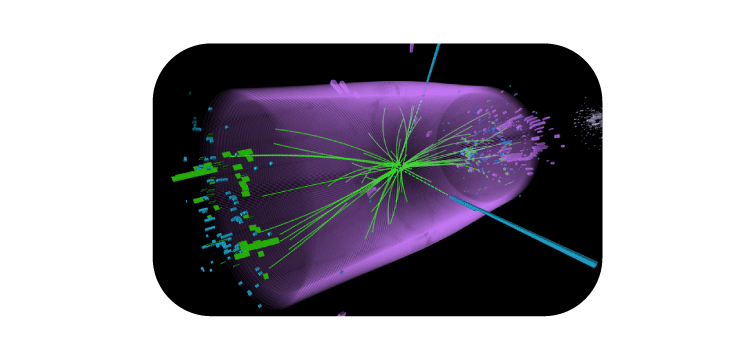The Higgs boson, often described as the “God Particle,” serves as a vital cornerstone in the edifice of particle physics, bridging the elusive world of Higgs fields with the corporeal realm of subatomic particles. To comprehend the intricacies of this relationship, one must first traverse the labyrinth of quantum mechanics, where particles exist not as definitive entities, but as waves of probability, endlessly oscillating in and out of existence.
At the crux of this discussion lies the Higgs field—a pervasive quantum field thought to exist throughout the universe. Imagine it as an expansive, ethereal medium—akin to an ocean of energy in which subatomic particles swim. The interactions of particles with the Higgs field dictate their mass, an essential characteristic that ultimately influences their behavior and role within the universe.
In a manner reminiscent of a ballroom filled with dancers, each particle interacts with the Higgs field with varying degrees of gracefulness. When a particle moves through this field, its inertia is modulated by a process akin to friction; some particles glide effortlessly, while others are encumbered with weighted burdens. This disparity in interaction manifests itself as mass. For instance, photons—particles of light—travel unimpeded through the Higgs field, remaining massless and enabling the swift propagation of light. In contrast, heavier particles such as the W and Z bosons experience substantial resistance, imbibing mass and consequently influencing the forces that govern the atom.
The discovery of the Higgs boson in 2012 at CERN’s Large Hadron Collider (LHC) was monumental. This elusive particle is intrinsically linked to the Higgs field, acting as its quantized excitation. Just as ripples on the surface of a pond signify disturbances within, the Higgs boson signifies the presence and vibrancy of the Higgs field. Its detection confirmed the existence of the Higgs mechanism, a theoretical framework posited by Peter Higgs and others in the 1960s to explain how particles acquire mass.
In the grand tapestry of particle physics, the Standard Model serves as the guiding narrative, delineating the fundamental particles and their interactions. Yet, the mass-generating mechanism is a linchpin that allows this model to coherently describe the myriad particles at play—from the ethereal neutrinos to the dense quarks. Without the Higgs field, all particles would remain massless, effectively precluding the formation of matter as we know it. The universe would possess a fundamentally different architecture, where atoms could not coalesce into the molecules that form stars, planets, and ultimately, life itself.
Furthermore, the relationship between the Higgs boson and subatomic particles extends to the exploration of symmetry and its spontaneous breaking. In particle physics, symmetries are foundational principles that govern interactions. The Higgs field embodies a mechanism of symmetry breaking; as the universe cooled after the Big Bang, it transitioned from a state of high symmetry to one where the Higgs field obtained a non-zero value. This transition released the grip of symmetry, allowing certain particles to acquire mass, while others—like the photon—remained agnostic to this process.
Gravitational interactions, governed by the framework of general relativity, intersect intriguingly with the behavior modulated by the Higgs field. While general relativity beautifully elucidates cosmic-scale phenomena, the subatomic world dances to the tune of quantum mechanics. Yet, the significance of mass within quantum mechanics cannot be overstated. The interplay of these two realms raises profound questions regarding the nature of gravity itself. If particles are intrinsically tied to the Higgs field, how do their masses influence gravitational interactions? This contemplation invites a deeper exploration into the very fabric of the cosmos.
Moreover, the implications of the Higgs boson extend into realms yet uncharted. The mass of particles is believed to influence the stability of nuclei and the processes that fuel stars. Speculations abound regarding the connection between Higgs bosons and dark matter, a mysterious substance postulated to comprise a significant portion of the universe’s mass. Understanding the characteristics of the Higgs boson may illuminate pathways toward comprehending the perplexing nature of dark matter and the universe’s ultimate fate.
As we delve deeper into the intricacies of theoretical physics, the Higgs boson emerges not only as a participant within the Standard Model but also as a potential key to unlocking enigmatic phenomena that baffle contemporary science. Its exploration prompts questions about the very nature of existence, the causation of mass, and the resultant interactions that bless our universe with complexity.
In summary, the relationship between the Higgs boson and subatomic particles is a quintessential fabric woven from the threads of mass acquisition, symmetry breaking, and the fundamental forces of nature. As our understanding continues to evolve, so does our appreciation for the Higgs field and its boson, standing as a testament to human curiosity and the relentless quest for knowledge. Irrespective of the intricate mathematical frameworks and theoretical constructs, it is ultimately the wonder of the universe—its particles, forces, and mysteries—that captivates the mind and instills a sense of awe in the face of the cosmos.












